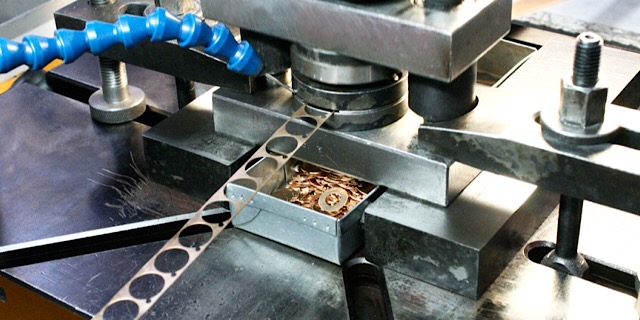Exploring the Role of Metal Stamping in Modern Engineering Solutions
Metal Stamping Technologies: Elevating Manufacturing Processes for Superior Results
In the realm of making procedures, steel stamping has actually long been a keystone strategy for creating a range of accuracy elements. With the unrelenting march of technological improvement, the landscape of steel stamping is going through a substantial improvement.
Advancement of Steel Marking Techniques

In addition, advancements in material science have caused the development of high-strength alloys that can now be seamlessly marked into intricate shapes, accommodating a wider variety of commercial applications. The assimilation of robotics and expert system has actually better maximized the stamping process by improving rate and precision while lowering the threat of human error.

Effect of Advanced Materials
Have innovative products changed metal marking processes dramatically in the manufacturing industry? By making use of materials such as high-strength alloys, advanced compounds, and innovative finishings, metal marking processes can now produce parts that are lighter, stronger, and much more sturdy than ever before.
These innovative materials supply remarkable mechanical residential properties, rust resistance, and thermal stability, enabling manufacturers to meet the needs of contemporary markets such as aerospace, auto, and electronic devices. In addition, using advanced materials in metal marking has promoted the manufacturing of intricate geometries and complex designs that were formerly unattainable with conventional approaches.
Moreover, the application of innovative products has actually resulted in lowered product waste, reduced production prices, and shorter preparations, making metal stamping procedures much more lasting and affordable. As technology remains to advance, the impact of advanced materials on metal stamping processes is expected to drive additional technology and boost the competition of makers in the worldwide market.
Automation in Steel Stamping
The development of metal stamping processes driven by the combination of sophisticated products has actually established the phase for significant improvements in automation within the production industry. Automation in steel stamping has changed manufacturing procedures, enhancing efficiency, accuracy, and general result top quality. Through the utilization of robotics, sensors, and computer-controlled systems, tasks that were lengthy and as soon as hands-on can now be performed with exceptional rate and accuracy.
Automation in steel stamping not only increases production rates yet also makes sure uniformity in the production process. By decreasing human intervention, the threat of errors is significantly minimized, causing greater levels of item uniformity and reliability. In addition, automation allows manufacturers to take on complicated marking tasks that would certainly be impractical or difficult to achieve by hand.
Additionally, automation in steel stamping adds to a more secure working atmosphere by minimizing the requirement for employees to take part in repetitive or hazardous tasks - Metal Stamping. This change in the direction of automation not just improves productivity yet likewise leads the way for the future of manufacturing, where technology plays a central function in driving functional quality
Quality Assurance and Assessment Systems
With a concentrate on precision and integrity, quality assurance and examination systems play a vital function in making sure product quality in metal stamping procedures. These systems are created to check every phase of manufacturing, from product inspection to the end product, to assure that all components fulfill the needed criteria. By executing innovative modern technologies such as optical evaluation systems, coordinate gauging devices (CMM), and automated assessing devices, makers can find also the tiniest variances in measurements, surface area high quality, and overall integrity of stamped components.

Sustainability Practices in Steel Stamping
Building upon the foundation of accuracy and dependability developed with high quality control and assessment systems, the assimilation of lasting methods in metal stamping processes is progressively ending up being a centerpiece for makers looking for to lessen ecological impact and optimize resource usage. Sustainability methods in metal stamping encompass a you can try these out series of initiatives focused on decreasing waste generation, energy intake, and greenhouse gas exhausts throughout the production procedure.
One key element of sustainability in steel marking is the fostering of environment-friendly products and modern technologies that advertise recyclability and waste decrease. By utilizing recycled materials and executing energy-efficient machinery, manufacturers can lower their carbon footprint and add to a much more lasting production cycle. Furthermore, enhancing manufacturing processes to decrease material waste and power use not only profits the environment yet likewise leads to set you back savings for organizations in the long run.
Additionally, the implementation of sustainable techniques in steel stamping can boost brand name reputation and interest environmentally conscious customers. As sustainability remains to gain significance in the production market, incorporating eco-friendly campaigns right into steel marking procedures is essential for long-term Clicking Here success and competition on the market.
Verdict
To conclude, metal marking techniques have actually substantially developed gradually, incorporating advanced products and automation to boost making processes. Quality assurance and assessment systems play an important function in ensuring premium outcomes, while sustainability methods are progressively being carried out to reduce environmental impact. These advancements in steel marking have reinvented the market, causing a lot more lasting and reliable production approaches for different sectors.
Steel stamping, when a guidebook and labor-intensive procedure, has changed right into a very automated and advanced approach of shaping steel sheets right into different forms and styles.Have innovative materials transformed steel marking processes substantially in the production industry? By using products such as high-strength alloys, progressed compounds, and ingenious finishes, metal stamping procedures can now create components that are lighter, more powerful, and much more durable than ever previously.
The development of steel marking procedures driven by the combination of innovative products has established the stage for substantial developments in automation i loved this within the production industry.In final thought, metal marking strategies have considerably progressed over time, including advanced products and automation to enhance manufacturing processes.